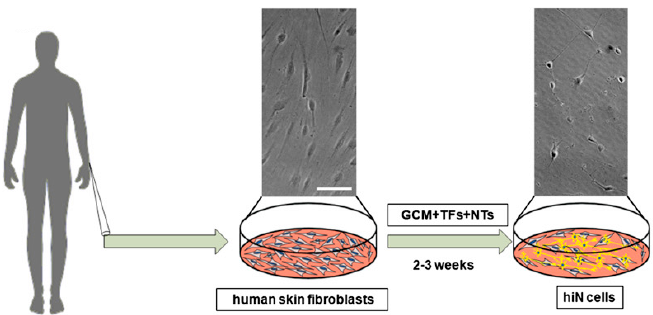Human skin cells converted directly into functional neurons
August 5, 2011

Schematic of the conversion from adult skin fibroblasts to human-induced neuronal cells. Top panels show phase contrast images of human skin fibroblast (left) or hiN cell (right) cultures. (Credit: Liang Qiang et al./Cell)
Researchers at Columbia University Medical Center have directly converted human skin cells into functional forebrain neurons, without the need for stem cells of any kind.
The researchers used a combination of transcription regulators, plus several neuronal support factors, to convert human skin cells into forebrain neurons. This bypassed the need for induced pluripotent stem (iPS) cells. The induced neurons appear to be the same as ordinary neurons, judging from electrophysiological testing and gene expression profiling. The researchers also showed that the neurons are able to send and receive signals in laboratory culture and when transplanted into the central nervous system of mice.
The researchers compared neurons made from skin cells of healthy individuals with neurons made from patients with early-onset Alzheimer’s disease. The latter cells exhibited altered processing and localization of amyloid precursor protein (APP) and increased concentration of amyloid beta, a component of APP (Alzheimer’s is thought to develop when abnormal amounts of amyloid beta accumulate in the brain, eventually killing neurons). APP was found to collect in the cells’ endosomes, cellular compartments that sort molecules for degradation or recycling. These findings suggest that this form of Alzheimer’s is caused, at least in part, by abnormal endosomal function, the researchers said.
The findings offer a new and potentially more direct way to produce replacement cell therapies for Alzheimer’s and other neurodegenerative diseases.
Ref.: Liang Qiang, et al., Directed Conversion Of Alzheimer’s Disease Patient Skin Fibroblasts Into Functional Neurons, Cell, 5 August 2011; 146(3) pp. 359 – 371 [DOI: 10.1016/j.cell.2011.07.007]